
Want an easy way to get people to click through to your website? Then include a meta description.
Although they aren’t a ranking factor, meta descriptions are essential to your SEO.
I mean, it’s the first impression searchers get of your website. A well-written meta description can be all it takes to capture a searcher’s interest in the search engine results pages (SERPs).
However, it can’t just be any old content.
If you want people to take that extra step and click through to your site, it’s got to be click-worthy, like the example below:
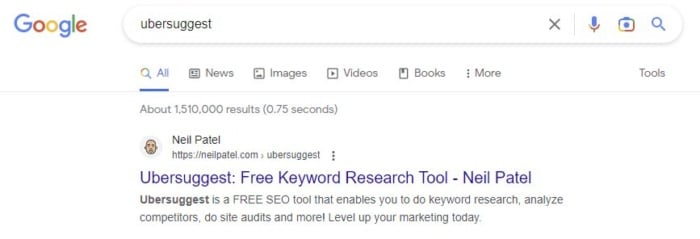
So, let’s talk about how to write meta descriptions that get clicks.
Ready? Great! Let’s start with an explanation.
What Are Meta Descriptions?
Meta descriptions are 160-character snippets summarizing a web page’s content. Search engines display these snippets in search results to let visitors know what a page is about before they click on it.
Meta descriptions help users decide whether to click on your website in a search result.
Here’s a meta description example from my site.
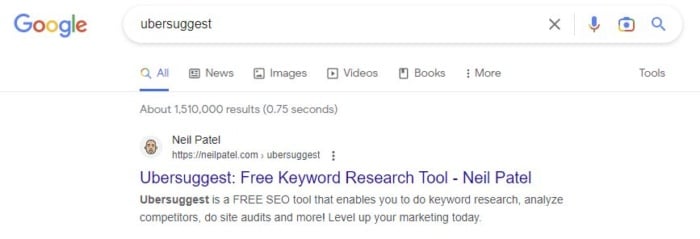
It gets right to the point and gives searchers a reason to click. That’s precisely what you want your meta description to do.
How Search Engines Use Meta Descriptions
The best examples of meta descriptions and how search engines use them come from search engines themselves. For starters, let’s look at Google’s meta description.

<meta name=“description” content=“Search the world’s information, including webpages, images, videos and more. Google has many special features to help you find exactly what you’re looking for.”>
It’s exactly 159 characters, including spaces.
Although they aren’t a ranking factor, meta descriptions and SEO go hand in hand because they help searchers find your site in the search engines (more about that later).
Search engines use meta descriptions as snippets of text that help them understand what your page is about, which in turn helps them rank your site for relevant queries.
Why Are Meta Descriptions Important?
Meta descriptions are important because the Google algorithm, which helps determine what pages should rank well for certain keywords, focuses on meta tags (including meta descriptions). This means that having meta data that is optimized and relevant to the content that you are putting out can have a direct positive effect on your rankings.
If you’re using meta descriptions properly, you can add a meta tag that isn’t in your content. This could be the difference between ranking on page 4 for “best shoes” or page 1.
Additionally, meta descriptions help:
- Increase click-through rates, boosting conversions and sales.
- Improve indexing to rank higher on SERPs.
- Make it easier for visitors to find the content they’re looking for without scanning page titles or meta tags.
Meta descriptions can also appear on social media when sharing a link.
Even search engine giant Google recommends writing meta descriptions on your site.
On the user experience side, meta descriptions show searchers what your website is about and what information they can expect to find if they click.
Want more reasons to use meta descriptions? Here they are:
Reason 1: Bolded Keywords in Search Results
Bolded keywords help you get searchers’ attention. When someone searches for a particular keyword or phrase, they’ll see it as a bold result in the SERPs. Therefore, if you’re targeting that keyword, you want it to stand out. In these results for marketing budget spending trends for 2023, which results jump out to you?
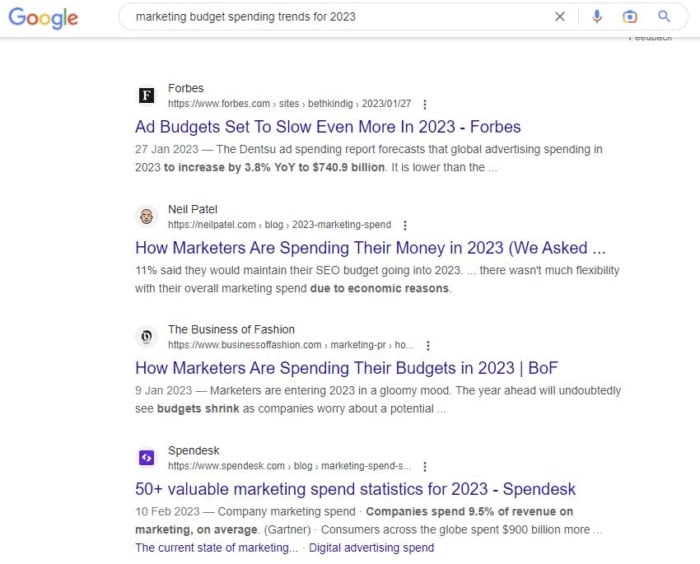
It goes to show why your top keyword phrase should be in your SEO title and meta description! You wouldn’t want to be the one result in this list with no bolded keywords for that search.
Reason 2: Top Social Networks Use It
Whenever you share a page on social networks like Facebook or LinkedIn, for example, each site pulls either the meta description or the first sentence or two of the post as the description to show in the share.
The meta description is usually shown in its entirety, while the first sentence or two of your post ends up cut off with an ellipsis […]. While you can edit the description for Facebook and LinkedIn, not everyone sharing your page will do so.
Therefore, if you want your page’s shares to get the most clicks on social media, consider creating a strong meta description that will encourage clicks, just like you would for search results.
Reason 3: Social Bookmarking Networks Use It
Many social bookmarking networks will also use the meta description as a page’s description on their network.
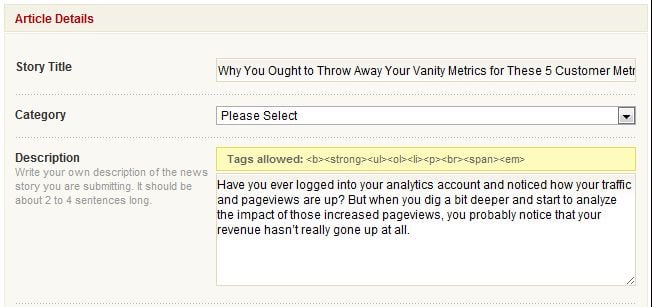
A few examples of networks that include meta descriptions are BizSugar and Pocket. Just about any social bookmarking or voting network built on the Pligg CMS system also uses the meta description first.
While you can edit the descriptions on these networks, you can’t count on whether others who submit your pages will. Plus, if you don’t have to edit the descriptions, then you save a little work for yourself if you are submitting your own pages.
How to Include Meta Descriptions on Your Pages
If you use WordPress on a self-hosted domain, you are in luck. You can easily add meta descriptions to your content using simple (and free) plugins such as All in One SEO Pack. Just install it, and look on every page/post for the SEO Details box that asks you for a custom SEO title, meta descriptions, and other information.
Then, you can add your homepage’s SEO details to the plugin’s main settings section. Other themes and platforms may have SEO options built in. If not, search your website’s platform, SEO plugin, add-on, or extension.
Properties of a Strong Meta Description
Now you know what meta descriptions are and why they matter, you’ll want to craft the best meta description possible.
The tips below and the examples help you do just that.
- First, ensure you write a meta description to avoid Google creating one for you.
- Keep it brief. Meta descriptions should be around 155 to 160 characters long, although 100 characters is an excellent middle ground to ensure that your meta description is also mobile friendly
- Make it easy to read.
- Include a call to action (CTA) to show readers what they get when they click your search result.
- Use active language and include relevant keywords to show users what they can expect from your page.
- Research relevant keywords for your web page and include them in the meta description organically.
- Don’t keyword stuff. This practice doesn’t belong in your content, and Google treats it like spam.
- Avoid vague or generic language like “Welcome to our website” that doesn’t tell users anything useful. Instead, make it descriptive and relevant.
Here are two examples of meta descriptions to show what you’re aiming for:


See? They’re short, sweet, and descriptive, like a meta description should be.
Tips for Writing Great Meta Descriptions
Meta descriptions are a great way to engage users on the SERPs and improve organic traffic.
You can use meta descriptions in several ways, including:
- Helping readers understand what the page offers.
- Giving users an incentive to click through and engage with your site.
- Selling a product, offering an email sign-up, or directing readers to your social media pages.
- Looking for employees.
How do you write a meta description that drives clicks and improves your ranking, though? I’ve got you! Here are nine tips to help you create more compelling meta descriptions.
1. Include a CTA in Your Meta Descriptions
A CTA in your meta descriptions is a great way to compel people to click on your website. For example, you can use phrases like “Learn More,” “Click Here,” or “Shop Now” to encourage searchers to click through.
For instance, this example from game designer Bungie asks users to apply for remote work positions from their Twitter accounts.

Do you know what else makes a searcher want to know more? Offering value. Let’s discuss that next.
2. Focus on Value in Your Meta Description
You can’t just expect people to click. You need to give them a reason. Describing the value they can gain by visiting your site motivates searchers to make that click.
Here’s how to do it!
First, be clear about what you’re offering so searchers can decide if it’s worth their while visiting your site.
For example, if your offer is informative, you could use words such as:
- Learn
- See
- Watch
Alternatively, if you offer a product or service, you could use words like:
- Best
- Deal/deals
- New
- Popular
- Packages
Look at how the travel companies use meta descriptions:
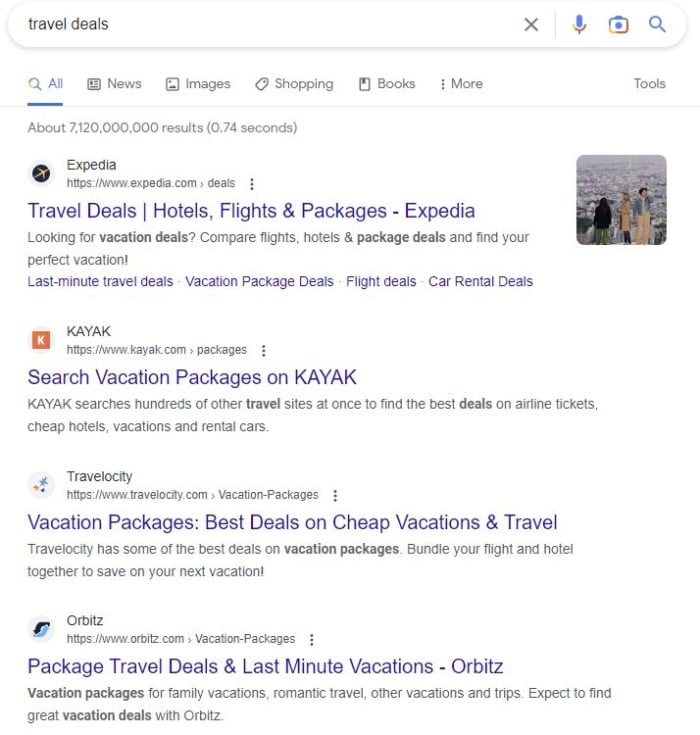
See how they make their meta descriptions stand out with words like “deal” and “best”? If I were looking for a vacation package or deal, these meta descriptions would grab my interest.
3. A/B Test Your Meta Descriptions
A meta description is a great place to experiment with different keywords, phrases, or CTAs.
This helps you determine what drives more engagement without doing anything permanent or drastic in your site’s design itself.
You can A/B test your meta descriptions by making two for each page.
For example, one meta description could use one variation of a keyword or CTA. The second meta description could be your current meta or focus on a different offer or term.
Run each meta for a few weeks, then check your Google Analytics to see which version earns more clicks. Then, use that information when crafting new meta descriptions.
Don’t just look at clicks, though. Track metrics like:
- Bounce rate
- Time on page
- Conversions
These tell you whether your meta descriptions are making an impact.
4. Experiment With Character Length
Using too many characters in your descriptions will result in your meta being truncated in the search results, which means users won’t see any content after the cut-off.
Here’s an example of a truncated meta. Notice the ellipses:

Yes, I know meta descriptions only give you 155 to 160 characters. However, that doesn’t mean you can’t experiment. Expert tip – pay attention to your pixel widths. Exceeding 960 pixels for desktop and 680 for mobile will lead to truncated results.
Even though it’s not a good idea to exceed the limit, you can test your meta description to see what works best for each page. For example, in-depth guides may get more clicks with the truncated results because users want to learn more.
You may find shorter meta descriptions work best on your home page, while blogs perform better with a higher word count. Or, you may discover meta descriptions with a higher word count work best for your recommended products page.
However, try to stay within the recommended character length, as it can negatively affect your rankings.
5. Make Your Meta Descriptions Unique and Interesting
Meta descriptions provide an overview of the page content, so they’ve got to stand out and grab your ideal visitor’s attention.
Whether your meta tags are on your homepage, sales pages, or e-commerce listings, you want your meta descriptions to inspire action.
How do you achieve this?
You could try the following:
- Use different approaches to grab user attention, such as using a clickbait title or asking a question users want answers to.
- Add eye-catching words or phrases that grab a user’s attention, such as “shocking,” “hilarious,” or “life-changing.”
- Include relevant keywords that accurately reflect the content of your page.
- Highlight your products or services’ unique qualities using descriptive language and strong adjectives in your meta description.
- Include relevant keywords that accurately reflect the content of your page.
Another way to create standout meta descriptions is by addressing the reader directly. Use active language and ask questions that pique their interest.
Finally, another approach you could take is using controversy or playful meta descriptions. I’m not saying you should make claims that aren’t true or set out to offend people. Here’s how Us Weekly does it:
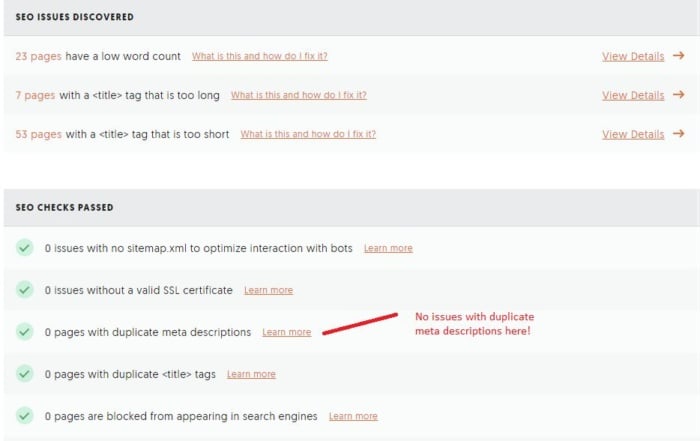
As you can see in the example above, they use controversy in the headline to inspire the reader to visit the site. If you were into celeb gossip, the headline alone is enticing enough to earn your click, right?
Whatever niche you’re in, you could take this approach. Just be careful not to overpromise and under-deliver.
6. Include Keywords in Your Meta Descriptions
Each meta description should contain one or two keywords per phrase, and they should be relevant to the page.
It’s important to include keywords in meta descriptions for two reasons:
1. It helps search engines understand the page and better rank your content.
2. It reassures users that the page covers the topic they are interested in.
Use a tool like Ubersuggest to find the best keywords for your site. Then, add them to your meta descriptions to improve your ranking.
Note: Each page should use different keywords in the meta descriptions to ensure your page shows up in all relevant searches.
Remember that Google does not use keyword meta tags directly in its rankings. However, that doesn’t mean they aren’t valuable for users.
7. Implement Structured Data
Structured data metatags are HTML tags you can add to your website to provide additional context for search engines and social media platforms.
Structured data can help you build a more powerful meta description that will help you rank higher in search results. They can also help you snag Google snippets.
The most common types of structured data meta tags marketers use are:
- Business name
- Address
- Phone number
- Email address
- Product description with price points (if applicable)
- Image URL
- Twitter handle
There are plenty of ways you can start implementing structured data.
One of the most popular ways you may have seen is when websites implement reviews in their meta description:
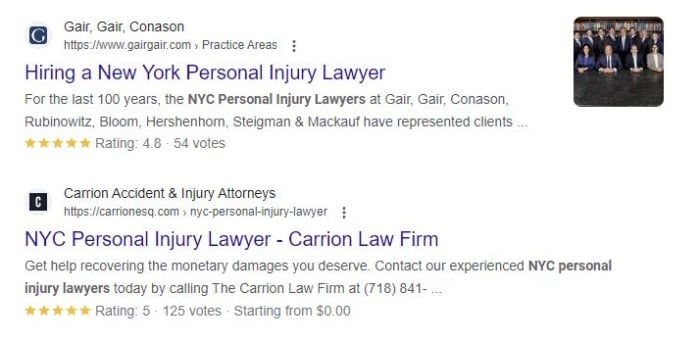
Positive reviews show searchers that they can trust you and that you offer a quality service or product.
Since social proof is such a powerful way to sell and grow your brand, this is a fairly easy hack that helps you capitalize on user behavior.
8. Do Not Duplicate Meta Descriptions
Unique meta descriptions increase the probability that search engines and other browsers can understand the content on a page and how it compares to other pages.
Duplicate meta descriptions can negatively affect your website, making it difficult for meta description crawlers to crawl your site.
Duplicates make it just as difficult for internet users, too.
For example, if searchers see duplicate meta descriptions on every page of your website, they won’t know what kind of content is on each page.
This is especially important for e-commerce sites, which may have several pages with similar content. Even if the products are alike, the meta should be unique.
Finally, if you’re unsure if duplicate meta descriptions are a problem on your website, take these steps:
Step #1: Visit Ubersuggest, enter your domain, and click search.

Step #2: Click Site Audit in the left sidebar, enter your domain again, and Ubersuggest will give you an overview of your website.
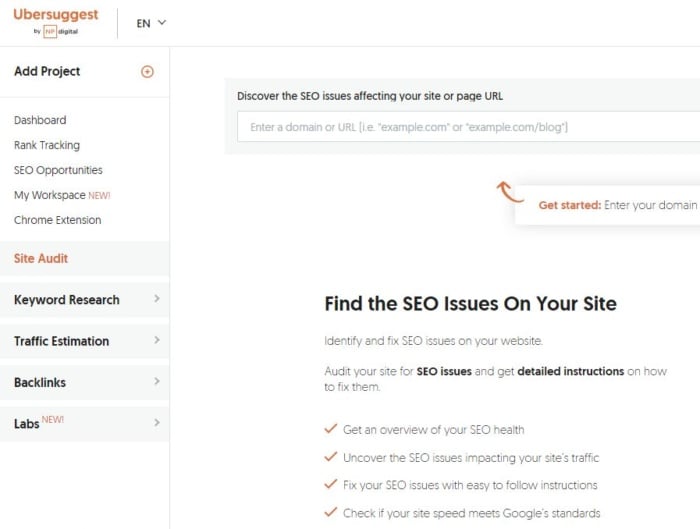
Step #3: Review SEO Issues Discovered and SEO Checks Passed to see if you have duplicate meta descriptions.
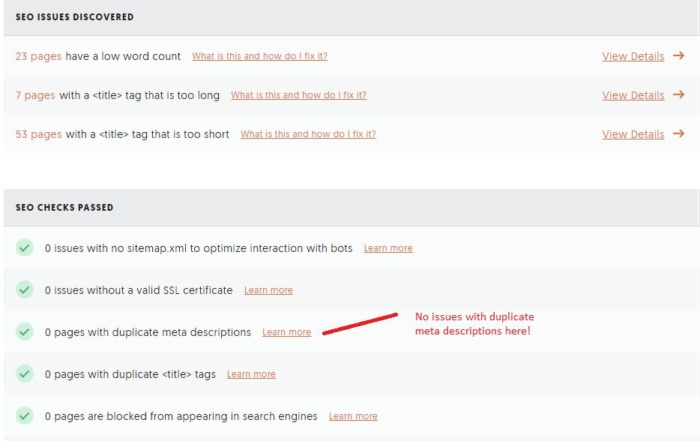
If you find any, click on the line. For the example above, I’d click on the words “What is this and how do I fix it?”
You’ll then get a popup with advice about how to resolve any issues.
There you are, your meta description duplication issues solved! Now, let’s look at using meta descriptions to inspire action.
9. Convert Your Meta Descriptions Into Calls to Action
You can use meta descriptions as a powerful call to action. Here are some tips you can use when writing your meta descriptions to encourage web searchers to take action:
- The power is in the language, so keep it clear and concise. How you phrase your descriptions can make or break your search engine result. Add words that describe value and give searchers a reason to click. Also, avoid vague statements that don’t offer any real value or incentive for the reader to click through.
- Write calls to action! Try adding language like “Click here,” “Learn more by clicking here,” “Shop now for the best deals on our products,” or “Learn more about our services.”
- Test them! If you have certain landing pages that receive a decent amount of organic traffic, consider testing different variations of meta descriptions to see if you can get a lift in click-throughs. For example, try different description lengths, phrasing, and positioning of your keywords.
- Identify your product or service’s unique features, then include this in your meta descriptions.
- Create a sense of urgency, like: “Don’t miss out on our limited-time offer” or “Join thousands of satisfied customers today!”
FAQs
To write an effective meta description, consider including relevant keywords and phrases that accurately describe the content on your web page.
Additionally, ensure:
Your meta description is unique and compelling.
You use active language.
That you highlight the benefits or solutions visitors can find on your page.
You include a call-to-action.
While Google doesn’t count meta descriptions as a ranking factor, meta descriptions still play a vital role in your SEO.
Why? The brief summary you provide in a meta description gives users an idea of what to expect. This entices viewers to engage as they can see that your content meets their needs.
Optimized meta descriptions can also enhance click-through rates.
The standard length for meta descriptions is 155 characters, but up to 160 is acceptable. Don’t forget to check the pixel widths of your meta descriptions to avoid truncated results. For mobile aim for 680 pixels, and for desktop 960 pixels.
Conclusion
Meta descriptions are an important part of your onsite SEO. They should be compelling, descriptive, and unique to each page.
Meta descriptions may be short, but they can help you rank higher in search engine results pages by helping search engines and users better understand what your page is about.
Remember to include meta descriptions on every page of your site, including blog posts and product pages.
What tips do you have for creating great meta descriptions?
About the Authors: Kristi Hines is a freelance writer, professional blogger, and social media enthusiast. Her blog Kikolani focuses on blog marketing for personal, professional, and business bloggers.
Sean Work is the former Marketing Director at KISSmetrics.

See How My Agency Can Drive More Traffic to Your Website
- SEO - unlock more SEO traffic. See real results.
- Content Marketing - our team creates epic content that will get shared, get links, and attract traffic.
- Paid Media - effective paid strategies with clear ROI.

Unlock Thousands of Keywords with Ubersuggest
Ready to Outrank Your Competitors?
- Find long-tail keywords with High ROI
- Find 1000s of keywords instantly
- Turn searches into visits and conversions
Free keyword research tool
